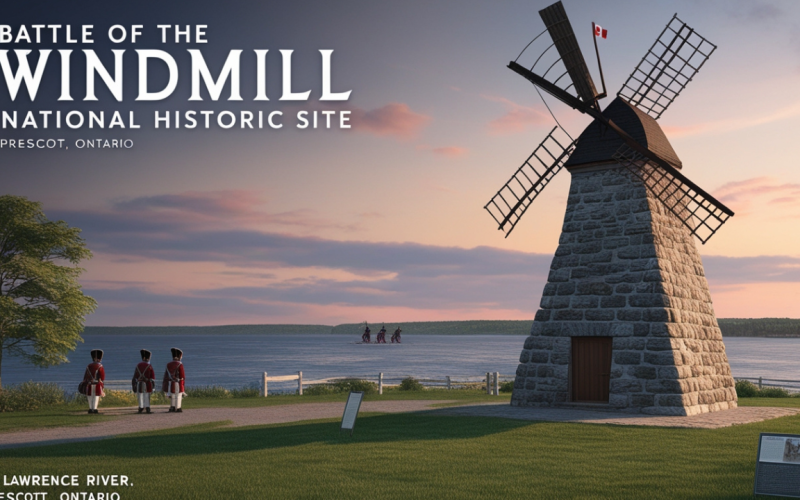Intro about Battle of the Windmill National Historic Site (Ontario)
Battle of the Windmill National Historic Site (Ontario), Nestled in the charming town of Prescott, Ontario, the Battle of the Windmill National Historic Site is a treasure trove of Canadian history.
It commemorates a pivotal moment in 1838 when a courageous coalition of British soldiers and Canadian loyalists united to defend Upper Canada against an invading force of American reformers and hunters.
This iconic site, located on Windmill Point overlooking the St. Lawrence River, preserves the legacy of a battle that shaped Canada’s future.
Key Takeaways
- The Battle of the Windmill was a defining moment in the defense of Upper Canada in November 1838.
- The site features a historic stone windmill, a structure central to the conflict and a symbol of resilience.
- It is located near Prescott, Ontario, and provides stunning views of the St. Lawrence River.
- Visitors can explore immersive exhibits, scenic landscapes, and a rich narrative of the Rebellions of 1837-1838.
- The site serves as a reminder of Canada’s colonial past and its journey toward unity and strength.
What is the Battle of the Windmill National Historic Site?
A Historic Gem in Upper Canada
Designated as a National Historic Site of Canada, the Battle of the Windmill site preserves the memory of one of the most important conflicts in Canadian history. Located near the town of Prescott, this site marks the location where Canadian and British forces successfully repelled an attempt by American reformers to incite rebellion in Upper Canada.
The site has become a symbol of the determination of Canadian loyalists to protect their land, culture, and government. It is not just a historical monument but also a place of reflection for visitors curious about the struggles and triumphs of Canada’s past.
The Significance of Windmill Point
The site’s name originates from the stone windmill, which was built in the early 1830s as a gristmill for the local community. During the battle, this sturdy, cylindrical building was transformed into a defensive stronghold by the invading force. Its thick stone walls withstood artillery fire, making it a critical point of contention during the conflict.
The History Behind the Battle
The Rebellions of 1837-1838
To understand the Battle of the Windmill, it’s essential to consider the context of the Rebellions of 1837-1838. These uprisings were driven by political reformers in Upper and Lower Canada who were dissatisfied with British colonial rule. Many reformers sought a more democratic government, free from the influence of the British elite.
In the aftermath of these rebellions, reformer sympathizers in the United States, known as Hunters, decided to take matters into their own hands. They formed a militia with the goal of overthrowing British control in Canada and replacing it with a republic.
The Battle of November 1838
On November 12, 1838, approximately 200 American invaders, armed with the belief that Canadians would join their cause, crossed the St. Lawrence River and occupied the windmill at Windmill Point. This strategic location, overlooking the river, allowed the invaders to monitor movements and hold their ground against advancing forces.
However, the invaders miscalculated the loyalty of local Canadians. Instead of rallying to their cause, the local population sided with the British redcoats and Canadian loyalists. Over several days, intense fighting ensued as approximately 1,000 Canadian and British troops launched an offensive to reclaim the windmill.
The Aftermath of the Battle
The invaders were eventually overpowered, and the stone windmill was retaken. Many of the surviving invaders were captured and tried for treason, with some facing execution. The victory reinforced Canada’s loyalty to the British Crown and marked the decline of American-led efforts to incite rebellion.
Exploring the Windmill National Historic Site Today
A Journey Through History
Stepping onto the grounds of the Battle of the Windmill National Historic Site feels like stepping back in time. The centerpiece of the site is the stone windmill, which has been preserved as a monument to the battle. Its weathered stones and cylindrical shape evoke the challenges and resilience of those who fought here.
Interpretive panels around the site provide detailed accounts of the events, offering visitors a chance to learn about the battle and its broader historical significance. The displays include maps, photographs, and narratives that bring the story to life.
The Scenic Beauty of Windmill Point
The site is perched on a hill overlooking the St. Lawrence River, providing breathtaking views of the waterway. Visitors can take in the tranquil scenery while reflecting on the turbulent history of the area. The surrounding landscape, with its rolling fields and proximity to the river, offers a striking contrast to the bloody battle fought here.
Interactive and Educational Experiences
The site features interactive exhibits that cater to visitors of all ages. Through multimedia presentations and hands-on displays, you can learn about the tactics used during the battle, the cultural tensions of the time, and the lives of those involved. Families will find these exhibits engaging and informative, making the site an excellent destination for educational outings.
Practical Information for Visitors
How to Get There
The Battle of the Windmill National Historic Site is located along Highway 2 near Prescott, Ontario. It is easily accessible by car and is approximately:
- 60 miles south of Ottawa
- A short drive from Kingston
- Conveniently near the U.S.-Canada border, making it a great destination for American visitors
| Category | Details |
|---|---|
| Address | Windmill Point, Prescott, ON |
| Season | May to October |
| Facilities | Parking, restrooms, gift shop |
Best Time to Visit
The site is open seasonally, typically from late spring to early fall. Summer is the ideal time to visit, with guided tours and reenactments available during peak season. Fall visitors will enjoy cooler weather and a quieter atmosphere.
Visitor Amenities
The site offers parking, restrooms, and a small gift shop where you can purchase souvenirs and educational materials. Nearby, the town of Prescott has additional amenities, including restaurants and accommodations for those planning an extended stay.
The Legacy of the Battle
Securing Upper Canada’s Future
The successful defense of the windmill ensured that Upper Canada remained under British control. This victory was a morale booster for loyalists and demonstrated the importance of unity during times of crisis.
A Monument to Resilience
The stone windmill stands as a symbol of perseverance. Its survival through the battle and the passage of time mirrors the endurance of Canadian identity and culture.
Connecting the Past to the Present
Visiting the site allows modern Canadians and visitors from around the world to connect with a defining moment in history. It reminds us of the sacrifices made to build a nation and the values of loyalty and unity that continue to shape Canada.
Why You Should Visit
The Battle of the Windmill National Historic Site offers a unique opportunity to immerse yourself in history while enjoying the natural beauty of the St. Lawrence River. Whether you’re a history enthusiast, a student, or someone looking for a scenic and educational outing, this site has something to offer. Its combination of historical significance and serene surroundings makes it a destination worth exploring.
My Opinion
The Battle of the Windmill National Historic Site is a testament to the resilience and determination of those who fought to protect Upper Canada. From its rich history to its stunning landscapes, the site offers an unforgettable experience for visitors. As you stand on Windmill Point, gazing across the St. Lawrence River, you can feel the echoes of history and appreciate the enduring legacy of this remarkable chapter in Canada’s story.






